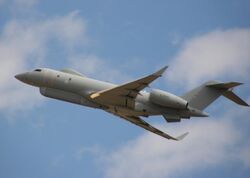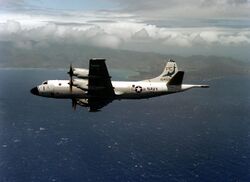Social:Surveillance aircraft

A surveillance aircraft is an aircraft used for surveillance—collecting information over time.[citation needed] They are operated by military forces and other government agencies in roles such as intelligence gathering, battlefield surveillance, airspace surveillance, observation (e.g. artillery spotting), border patrol and fishery protection. This article concentrates on aircraft used in those roles, rather than for traffic monitoring, law enforcement and similar activities.
Surveillance aircraft usually carry no armament, or only limited defensive armament. A surveillance aircraft does not necessarily require high-performance capability or stealth characteristics. It may be a modified civilian aircraft. Surveillance aircraft have also included moored balloons (e.g. TARS) and unmanned aerial vehicles (UAVs).
Definitions
Northrop representative quoted by Flight International (2010)
from USAF research report, 2001
The terms “surveillance” and “reconnaissance” have sometimes been used interchangeably, but, in the military context, a distinction can be drawn between surveillance, which monitors a changing situation in real time, and reconnaissance, which captures a static picture for analysis.[citation needed]
Surveillance is sometimes grouped with Intelligence, Target acquisition and Reconnaissance under the title ISTAR.
Observation was the term used for surveillance when the main sensor was the human eye.
History
Pre World War I

In 1794, during the Battle of Fleurus, the French Aerostatic Corps balloon L'Entreprenant remained afloat for nine hours. French officers used the balloon to observe the movements of the Austrian Army, dropping notes to the ground for collection by the French Army,[3] and also signalled messages using semaphore.[4]
World War I
One of the first aircraft used for surveillance was the Rumpler Taube during World War I, when aviators like Fred Zinn evolved entirely new methods of reconnaissance and photography. The translucent wings of the plane made it very difficult for ground-based observers to detect a Taube at an altitude above 400 m. The French also called this plane "the Invisible Aircraft", and it is sometimes also referred to as the "world's very first stealth plane". German Taube aircraft were able to detect the advancing Russian army during the Battle of Tannenberg (1914).
World War II
During World War II, light aircraft such as the Auster were used as air observation posts. Officers from the British Royal Artillery were trained as pilots to fly AOP aircraft for artillery spotting.[5] The air observation role was generally taken over by light observation helicopters, such as the Hughes OH-6 Cayuse, from the mid-1960s.
Pre war, the British identified a need for an aircraft that could follow and observe the enemy fleet at a distance. To this end the slow-flying Airspeed Fleet Shadower and General Aircraft Fleet Shadower designs were built and flown in 1940 but they were made obsolete by the introduction of airborne radar.
Cold War
Spy flights were a source of major contention between the US and Soviet Union during most of the 1960s.[6]
Roles
Maritime patrol

Maritime patrol aircraft are typically large, slow machines capable of flying continuously for many hours, with a wide range of sensors. Such aircraft include the Hawker-Siddeley Nimrod, the Breguet Atlantique, the Tupolev Tu-95, the Lockheed P-2 Neptune and the Lockheed P-3 Orion/CP-140 Aurora.
Law enforcement
Predator UAVs have been used by the US for border patrol.[7]
Battlefield and airspace surveillance
Current use
Unmanned (UAV) surveillance aircraft have been deployed or are under development in many countries, including Israel, the UK, the United States, Canada, China, India, South Africa and Pakistan.[citation needed]
Unmanned surveillance UAVs include both airships—such as Sky Sentinel[8] and HiSentinel 80[9]—and airplanes.
Most air forces around the world lack dedicated surveillance planes.[citation needed]
Several countries adapt aircraft for electronic intelligence (ELINT) gathering. The Beech RC-12 Super King Air and Boeing RC-135 Rivet Joint are examples of this activity.[citation needed]
Business aircraft
With smaller equipment, long-range business aircraft can be modified in surveillance aircraft to perform specialized missions cost-effectively, from ground surveillance to maritime patrol:[10]
- the 99,500 lb (45,100 kg), 6,000 nmi Bombardier Global 6000 is the platform for the USAF Northrop Grumman E-11A Battlefield Airborne Communications Node, the radar-carrying ground-surveillance Raytheon Sentinel for the UK Royal Air Force , and Saab’s Globaleye AEW&C carrying its Erieye AESA radar as UK's Marshall ADG basis for Elint/Sigint for the United Arab Emirates; it is also the base for the proposed Saab AB Swordfish MPA and the USAF Lockheed Martin J-Stars Recap battlefield-surveillance program, while IAI's ELI-3360 MPA is based on the Global 5000;
- The 91,000 lb (41,000 kg), 6,750 nmi Gulfstream G550 was selected for the IAI EL/W-2085 Conformal Airborne Early Warning AESA radar for Italy, Singapore and Israel (which also has IAI Sigint G550s) while L3 Technologies transfers the U.S. Compass Call electronic-attack system to the G550 CAEW-based EC-37B, like the NC-37B range-support aircraft, and will modify others for Australia’s AISREW program, Northrop Grumman proposes the G550 for the J-Stars Recap;
- Dassault Aviation developed the Falcon 900 MPA and Falcon 2000 Maritime Multirole Aircraft for France (which delayed its Avsimar requirement), South Korea and the Japan Coast Guard with a mission system developed with L3 and Thales Group;
- Embraer delivered several EMB-145s as a platform for AEW&C, MPA and multi-intelligence;
- the Beechcraft King Air 350ER is a platform for ISR versions, including L3’s Spyder II and Sierra Nevada Corp.’s Scorpion and as the MC-12W for the U.S. Army.
See also
- HALE aircraft
- MikroKopter
- Reconnaissance aircraft
- Treaty on Open Skies
- Micro air vehicle
References
- ↑ Next generation of Global Hawks ready to roll, Flight International, August 16, 2010
- ↑ The Rise of Surveillance, Lt Col James O. Norman, USAF (page 18)
- ↑ F. Stansbury Haydon, Military Ballooning During the Early Civil War, pp. 5–15.
- ↑ Charles Coulston Gillispie, Science and Polity in France: The Revolutionary and Napoleonic Years, pp. 372–373.
- ↑ Canadian Warplane Heritage: Auster Beagle AOP
- ↑ "Reds, U.S. Face Hot Plane Debate at U.N.". The Paris News. Associated Press (Paris, Texas (US)): pp. 1. May 23, 1960.
- ↑ "LA Now – Southern California, December 7, 2009,". Latimesblogs.latimes.com. December 7, 2009. http://latimesblogs.latimes.com/lanow/2009/12/drone-aircraft-will-be-used-to-nab-illegal-immigrants-on-californiamexico-border.html. Retrieved May 20, 2010.
- ↑ Govers, Francis X., III (2013-06-11). "Nevada company launches silent Sky Sentinel UAV airship". gizmag.com. http://www.gizmag.com/unmanned-airship-silent-sentinel/27867/. Retrieved 2014-08-16.
- ↑ Perry, William D. (Fall–Winter 2010). "Sentinel in the Sky". Technology Today. http://www.swri.org/3pubs/ttoday/Fall10/PDFs/Sentinel-in-the-Sky.pdf. Retrieved 2014-08-16.
- ↑ Graham Warwick (Jan 10, 2018). "Spotlight on Bizjet-based Special Mission Aircraft". Aviation Week & Space Technology. http://aviationweek.com/business-aviation/spotlight-bizjet-based-special-mission-aircraft.
External links
- US Centennial of Flight Commission: "Military Use of Balloons During the Napoleonic Era". Retrieved April 1, 2007.

